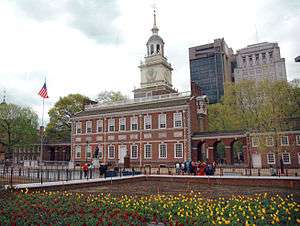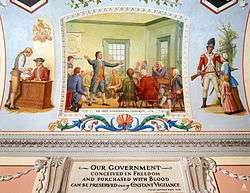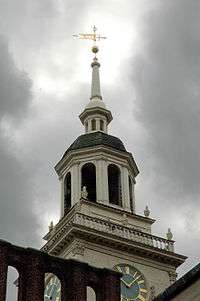First Continental Congress
| The First Continental Congress | |
|---|---|
| Thirteen Colonies | |
|
First Continental Congress 1774 | |
| Type | |
| Type | |
| History | |
| Preceded by | Stamp Act Congress |
| Succeeded by | Second Continental Congress |
| Leadership | |
Secretary | |
| Seats | 56 from 12 colonies (excluding Georgia) |
| Meeting place | |
| Carpenters' Hall, Philadelphia | |
| This article is part of a series on the |
| United States Continental Congress |
|---|
 |
| Predecessors |
|
| 1st Continental Congress |
| 2nd Continental Congress |
| Congress of the Confederation |
| Members |
|
|
The First Continental Congress was a meeting of delegates from twelve of the Thirteen Colonies who met from September 5 to October 26, 1774 at Carpenters' Hall in Philadelphia, Pennsylvania early in the American Revolution. It was called in response to the Intolerable Acts passed by the British Parliament, which the British referred to as the Coercive Acts, with which the British intended to punish Massachusetts for the Boston Tea Party.
The Congress met briefly to consider options, including an economic boycott of British trade and drawing up a list of rights and grievances; in the end, they petitioned King George III for redress of those grievances.
The Congress also called for another Continental Congress in the event that their petition was unsuccessful in halting enforcement of the Intolerable Acts. Their appeal to the Crown had no effect, and so the Second Continental Congress was convened the following year to organize the defense of the colonies at the onset of the American Revolutionary War. The delegates also urged each colony to set up and train its own militia.
Convention
The Congress met from September 5 to October 26, 1774. Peyton Randolph presided over the proceedings; Henry Middleton took over as President of the Congress from October 22 to 26. Charles Thomson, leader of Philadelphia Committee of Correspondence, was selected to be Secretary of the Continental Congress.[1]
The delegates who attended were not of one mind concerning why they were there. Conservatives such as Joseph Galloway, John Dickinson, John Jay, and Edward Rutledge believed their task to be forging policies to pressure Parliament to rescind its unreasonable acts. Their ultimate goal was to develop a reasonable solution to the difficulties and bring about reconciliation between the Colonies and Great Britain. Others such as Patrick Henry, Roger Sherman, Samuel Adams, and John Adams believed their task to be developing a decisive statement of the rights and liberties of the Colonies. Their ultimate goal was to end what they felt to be the abuses of parliamentary authority, and to retain their rights which had been guaranteed under both Colonial charters and the English constitution.[2]
Roger Sherman denied the legislative authority of Parliament, and Patrick Henry believed that the Congress needed to develop a completely new system of government, independent from Great Britain, for the existing Colonial governments were already dissolved.[3] In contrast to these ideas, Joseph Galloway put forward a "Plan of Union" which suggested that an American legislative body be formed with some authority, whose consent would be required for imperial measures.[3][4]
Declaration and Resolves
In the end, the voices of compromise carried the day. Rather than calling for independence, the First Continental Congress passed and signed the Continental Association in its Declaration and Resolves, which called for a boycott of British goods to take effect in December 1774. It requested that local Committees of Safety enforce the boycott and regulate local prices for goods. These resolutions adopted by the Congress did not endorse any legal power of Parliament to regulate trade, but consented, nonetheless, to the operation of acts for that purpose. Furthermore, they did not repudiate control by the royal prerogative, which was explicitly acknowledged in the Petition to the King a few days later.
Accomplishments
The Congress had two primary accomplishments. The first was a compact among the Colonies to boycott British goods beginning on December 1, 1774.[5] The West Indies were threatened with a boycott unless the islands agreed to non-importation of British goods.[6] Imports from Britain dropped by 97 percent in 1775, compared with the previous year.[5] Committees of observation and inspection were to be formed in each Colony to ensure compliance with the boycott. All of the Colonial Houses of Assembly approved the proceedings of the Congress, with the exception of New York.[7]
If the Intolerable Acts were not repealed, the Colonies would also cease exports to Britain after September 10, 1775.[5] The boycott was successfully implemented, but its potential for altering British colonial policy was cut off by the outbreak of the American Revolutionary War.
The second accomplishment of the Congress was to provide for a Second Continental Congress to meet on May 10, 1775. In addition to the Colonies which had sent delegates to the First Continental Congress, the Congress resolved on October 21, 1774 to send letters of invitation to Quebec, Saint John's Island (now Prince Edward Island), Nova Scotia, Georgia, East Florida, and West Florida.[8] However, letters appear to have been sent only to Quebec (three letters in all). None of these other colonies sent delegates to the opening of the Second Congress, though a delegation from Georgia arrived the following July.[9]
List of delegates
| # | Name | Colony | Notes |
|---|---|---|---|
| 1 | Folsom, NathanielNathaniel Folsom | New Hampshire | |
| 2 | Sullivan, JohnJohn Sullivan | New Hampshire | 3rd and 5th Governor of New Hampshire, general in the Continental Army |
| 3 | Adams, JohnJohn Adams | Massachusetts | Lawyer, first vice-president of the United States, and second President |
| 4 | Adams, SamuelSamuel Adams | Massachusetts | "Father of the American Revolution," cousin of John Adams |
| 5 | Cushing, ThomasThomas Cushing | Massachusetts | |
| 6 | Paine, Robert TreatRobert Treat Paine | Massachusetts | |
| 7 | Hopkins, StephenStephen Hopkins | Rhode Island | Authored pamphlet: 'The Rights of the Colonies" |
| 8 | Ward, SamuelSamuel Ward | Rhode Island | |
| 9 | Deane, SilasSilas Deane | Connecticut | |
| 10 | Dyer, EliphaletEliphalet Dyer | Connecticut | |
| 11 | Sherman, RogerRoger Sherman | Connecticut | Created the Great Compromise and Three-Fifths Compromise at the Constitutional Convention, Congressman, and a member of the Committee of Five who presented the Declaration of Independence |
| 12 | Duane, JamesJames Duane | New York | Appointed by the Committee of Fifty-one of the City and County of New York and authorized by the counties of Albany, Duchess, and Westchester. |
| 13 | Jay, JohnJohn Jay | New York | Lawyer; First Chief Justice of the United States, co-wrote The Federalist Papers. Appointed by the Committee of Fifty-one of the City and County of New York and authorized by the counties of Albany, Duchess, and Westchester. |
| 14 | Livingston, PhilipPhilip Livingston | New York | Appointed by the Committee of Fifty-one of the City and County of New York and authorized by the counties of Albany, Duchess, and Westchester. |
| 15 | Low, IsaacIsaac Low | New York | Appointed by the Committee of Fifty-one of the City and County of New York and authorized by the counties of Albany, Duchess, and Westchester. |
| 16 | Boerum, SimonSimon Boerum | New York | For Kings County: "two persons assembled; one was made chairman, the other clerk; and the latter certified to the congress that the former, Simon Boerum, was unanimously chosen".[10] |
| 17 | Haring, JohnJohn Haring | New York | Appointed by the General Meeting of all the Committees of the County of Orange. |
| 18 | Wisner, HenryHenry Wisner | New York | Appointed by the General Meeting of all the Committees of the County of Orange. |
| 19 | Floyd, WilliamWilliam Floyd | New York | For Suffolk County. |
| 20 | Alsop, JohnJohn Alsop | New York | Appointed by the Committee of Fifty-one of the City and County of New York and authorized by the counties of Albany, Duchess, and Westchester. |
| 21 | Crane, StephenStephen Crane | New Jersey | |
| 22 | De Hart, JohnJohn De Hart | New Jersey | |
| 23 | Kinsey, JamesJames Kinsey | New Jersey | |
| 24 | Livingston, WilliamWilliam Livingston | New Jersey | |
| 25 | Smith, RichardRichard Smith | New Jersey | |
| 26 | Biddle, EdwardEdward Biddle | Pennsylvania | |
| 27 | Dickinson, JohnJohn Dickinson | Pennsylvania | author of Letters from a Farmer in Pennsylvania |
| 28 | Galloway, JosephJoseph Galloway | Pennsylvania | Originator of the Galloway Plan of Union |
| 29 | Humphreys, CharlesCharles Humphreys | Pennsylvania | |
| 30 | Mifflin, ThomasThomas Mifflin | Pennsylvania | Later served as the first governor of Pennsylvania; Quartermaster general of the U.S. Army |
| 31 | Morton, JohnJohn Morton | Pennsylvania | |
| 32 | Rhoads, SamuelSamuel Rhoads | Pennsylvania | |
| 33 | Ross, GeorgeGeorge Ross | Pennsylvania | |
| 34 | McKean, ThomasThomas McKean | Delaware | |
| 35 | Read, GeorgeGeorge Read | Delaware | |
| 36 | Rodney, CaesarCaesar Rodney | Delaware | |
| 37 | Chase, SamuelSamuel Chase | Maryland | Future Associate Justice on the Supreme Court |
| 38 | Goldsborough, RobertRobert Goldsborough | Maryland | |
| 39 | Johnson, ThomasThomas Johnson | Maryland | |
| 40 | Paca, WilliamWilliam Paca | Maryland | |
| 41 | Tilghman, MatthewMatthew Tilghman | Maryland | |
| 42 | Bland, RichardRichard Bland | Virginia | |
| 43 | Harrison, BenjaminBenjamin Harrison | Virginia | Later served as the fifth governor of Virginia; father of President William Henry Harrison and great-grandfather of President Benjamin Harrison |
| 44 | Henry, PatrickPatrick Henry | Virginia | Prominent Virginian lawyer, creator of the 'Virginia Stamp Act Resolutions'. |
| 45 | Lee, Richard HenryRichard Henry Lee | Virginia | Would later submit movement for independence from Britain at the Second Continental Congress. |
| 46 | Pendleton, EdmundEdmund Pendleton | Virginia | |
| 47 | Randolph, PeytonPeyton Randolph | Virginia | Presided over this first gathering of a Congress. |
| 48 | Washington, GeorgeGeorge Washington | Virginia | Future commander of the Continental Army, and first president of the United States |
| 49 | Caswell, RichardRichard Caswell | North Carolina | |
| 50 | Hewes, JosephJoseph Hewes | North Carolina | Secretary of Naval Affairs Committee in 1776 |
| 51 | Hooper, WilliamWilliam Hooper | North Carolina | |
| 52 | Gadsden, ChristopherChristopher Gadsden | South Carolina | |
| 53 | Lynch, Jr., ThomasThomas Lynch, Jr. | South Carolina | |
| 54 | Middleton, HenryHenry Middleton | South Carolina | |
| 55 | Rutledge, EdwardEdward Rutledge | South Carolina | |
| 56 | Rutledge, JohnJohn Rutledge | South Carolina | 2nd Chief Justice, Associate Justice; 1st Governor of South Carolina |
See also
- List of delegates to the Continental and Confederation congresses
- Papers of the Continental Congress
- Timeline of United States revolutionary history (1760–1789)
Notes
- ↑ Risjord, Norman K. (2002). Jefferson's America, 1760-1815. Rowman & Littlefield. p. 114.
- ↑ McLaughlin, Andrew C. (1936). "A constitutional History of the United States". New York, London: D. Appleton-Century Company. pp. 83–90. Retrieved August 27, 2014.
- 1 2 Greene, Evarts Boutell (1922). The Foundations of American Nationality. American Book Company. p. 434.
- ↑ Miller, Marion Mills (1913). Great Debates in American Hist: From the Debates in the British Parliament on the Colonial Stamp. Current Literature Pub. Co. p. 91.
- 1 2 3 Kramnick, Isaac (ed); Thomas Paine (1982). Common Sense. Penguin Classics. p. 21.
- ↑ Ketchum, pg. 262
- ↑ Launitz-Schurer pg. 144
- ↑ Worthington C. Ford, Library of Congress (United States); et al., eds. (1774 (printed 1901)). Journals of the Continental Congress, 1774-1789. p. 101. Retrieved Feb 7, 2010. Check date values in:
|date=(help) - ↑ Worthington C. Ford; et al. (eds.). Journals of the Continental Congress, 1774–1789. pp. 2:192–193.
- ↑ Becker, Carl Lotus (1909). The History of Political Parties in the Province of New York, 1760-1776. University of Wisconsin–Madison. pp. 139–141.
References
- Bancroft, George. History of the United States of America, from the discovery of the American continent. (1854–78), vol 4-10 online edition
- Burnett, Edmund C. (1975) [1941]. The Continental Congress. Greenwood Publishing. ISBN 0-8371-8386-3.
- Henderson, H. James (2002) [1974]. Party Politics in the Continental Congress. Rowman & Littlefield. ISBN 0-8191-6525-5.
- Launitz-Schurer, Loyal Whigs and Revolutionaries, The making of the revolution in New York, 1765-1776, 1980, ISBN 0-8147-4994-1
- Ketchum, Richard, Divided Loyalties, How the American Revolution came to New York, 2002, ISBN 0-8050-6120-7
- Miller, John C. Origins of the American Revolution (1943) online edition
- Puls, Mark, Samuel Adams, father of the American Revolution, 2006, ISBN 1-4039-7582-5
- Montross, Lynn (1970) [1950]. The Reluctant Rebels; the Story of the Continental Congress, 1774–1789. Barnes & Noble. ISBN 0-389-03973-X.
- Primary sources
- Peter Force, ed. American Archives, 9 vol 1837-1853, major compilation of documents 1774-1776. online edition
External links
- Full text of Journals of the Continental Congress, 1774-1789
- Papers of the Continental Congress (Digitized Original Documents)
| Preceded by Stamp Act Congress |
Legislature of the United States September 5, 1774 to October 26, 1774 |
Succeeded by the Second Continental Congress |


